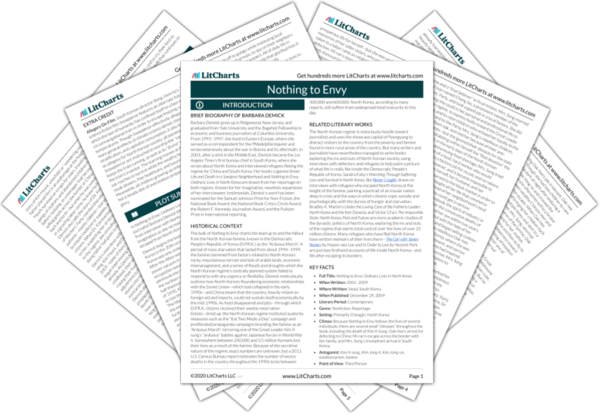Welcome to the LitCharts study guide on Barbara Demick's Nothing to Envy. Created by the original team behind SparkNotes, LitCharts are the world's best literature guides.
Nothing to Envy: Introduction
Nothing to Envy: Plot Summary
Nothing to Envy: Detailed Summary & Analysis
Nothing to Envy: Themes
Nothing to Envy: Quotes
Nothing to Envy: Characters
Nothing to Envy: Terms
Nothing to Envy: Symbols
Nothing to Envy: Theme Wheel
Brief Biography of Barbara Demick

Historical Context of Nothing to Envy
Other Books Related to Nothing to Envy
- Full Title: Nothing to Envy: Ordinary Lives in North Korea
- When Written: 2001–2009
- Where Written: Seoul, South Korea
- When Published: December 29, 2009
- Literary Period: Contemporary
- Genre: Nonfiction; Reportage
- Setting: Primarily Chongjin, North Korea
- Climax: Because Nothing to Envy follows the lives of several individuals, there are several small “climaxes” throughout the book, including the death of Kim Il-Sung; Oak-hee’s arrest for defecting to China; Mi-ran’s escape across the border with her family; and Mrs. Song’s triumphant arrival in South Korea.
- Antagonist: Kim Il-sung, Kim Jong-il, Kim Jong-un, totalitarianism, famine
- Point of View: Third Person
Extra Credit for Nothing to Envy
Allegory On Film. South Korean director Bong Joon-ho’s 2013 science fiction film Snowpiercer features an alternate future in which the last of humanity has confined itself to a fast-moving circumnavigational train in order to escape freezing-cold temperatures. Though Snowpiercer effectively allegorizes the more general effects of climate science denial, class stratification, and capitalist consumption, it also lends itself to an allegory for North Korean society: all passengers aboard the Snowpiercer are instructed to worship the “sacred engine” that keeps the train running, as well as its “divine” steward, Wilford, the train’s inventor. The starving masses at the back of the train eat roaches to survive while the wealthy few at the front enjoy steak dinners, free healthcare, and luxurious spa cars. Meanwhile, all children growing up onboard the train are daily fed a steady diet of overzealous propaganda about Wilford’s glory.












